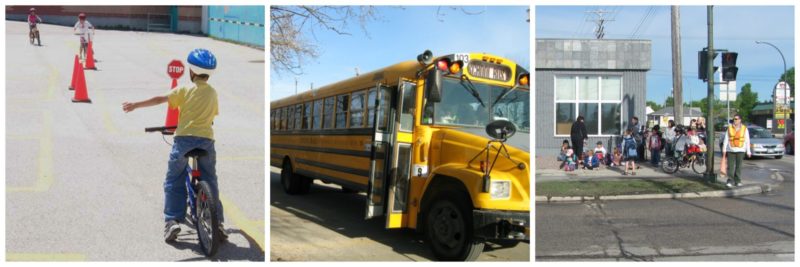
A recent Winnipeg School Division bus policy has sparked outcry from many parents. As a means to cut costs, the WSD is ending a policy that previously allowed children who didn’t qualify to take the bus to be included, provided that parents paid a monthly fee to cover costs, there was space on the bus, and that the bus did not need to be rerouted. This is causing panic amongst parents whose children require transportation to school from daycare, but will no longer be included because the school only considers the home address for pickup.The division’s current policy will only allow students who live further than 1.6 km from the school to take the bus. Read the full CBC article here.
We recognize that this is one of the many challenges parents face when getting their children to school. Our Active and Safe Routes to School program specializes in active school travel, so we are responding by advocating for active transportation as a healthy and meaningful alternative. To do this, we will outline the responsibilities of School Divisions with respect to active school travel and our solutions for the most common challenges parents face with active school travel and when to go with it.
SCHOOL DIVISION RESPONSIBILITIES
With leadership on active school travel coming from policy creation by key provincial departments, school divisions would be bound to implement some or all of the following recommendations:
1) Implement the following health, safety and environmental policies that encourage active school travel for as many children as possible:
- Plan school sites with walkability principles in mind, such as building smaller schools that serve communities within active transportation distance, paving smaller parking lots, eliminating parent drop-off loops and adding new building code requirements that mandate a bike rack and equipment storage locker per number of paved parking spaces.
- Encourage schools to register as a Healthy School in motion, to participate in the Healthy Schools initiative, and to apply for recognition as an Eco-Globe School.
- Implement anti-idling policies encouraging all drivers, including school bus drivers, to curb fuel consumption by changing their driving habits (see Fuel Savings Calculator and ecoDriver Manitoba).
2) Designate resources to support the needs of students who use active transportation, e.g. add active school travel to school division transportation responsibilities, either by expanding the mandate of the school division’s transportation policies and adding an active school travel staff position.
3) Recognize the full cost of supporting vehicular transportation by performing a cost analysis of parking lot creation and maintenance including snow removal, and line painting.
To learn more on active school travel and to make the case for why schools and divisions should prioritize active school travel, download and read Saving Money and Time with Active School Travel.
CONCERNS OF SCHOOL TRAVEL
Road Safety
- Identify routes to and/or from school that provide infrastructure that improves safety (i.e. crosswalks). Make a map of routes with your children and practice it together if your child independently travels to school
- Encourage fellow parents and neighbours to adhere to safe driving behaviours including measures to increase safety of children (speed limit of 30 km/h and no ‘double parking’).
- Go over and discuss safety tips for travelling to and from school with your children.
- Kiss ‘n’ Ride systems reduce traffic congestion around schools, making it safer for those children that are walking and cycling.
- Call 311 to report safety concerns in your neighborhood, or the non-emergency police line 204-986-6222 to report reckless driving.
Weather Conditions
- Make sure children seasonally appropriate clothing. This also includes sunscreen and umbrellas!
- Pack an extra pair of socks and mittens, so wet items can be changed.
- Keep in mind that children are spending time outdoors during recess, and are therefore able to handle a walk/ bike ride to and/or from school.
Lack of Time/Flexibility
- Make arrangements in your schedule to prioritize active travel to school for your children.
- Keep in mind the benefits of walking or cycling to school for your children.
- There are a number of things you can do the night before to free up more time in the morning to walk/ bike your children to school, like packing lunches, taking showers, picking out an outfit, packing backpacks, checking the weather, etc.
- Coordinate with a neighbor or family member who has more flexibility to walk or bike your children to and/or from school. You can even form a walking school bus / bike train!
“Stranger Danger”
- Set up a walking bus with convenient drop off and pick up points to encourage children to walk part of the way with supervision.
- Encourage your children to be streetwise by talking through potential problems with them and how they should react.
- Promote walking buddies and make sure your children walk with their friends safely and that younger children are accompanied by adults or older children.
- Identify safe places and people along frequently used routes.
- Promote a Neighbourhood Watch Program in your area.
- To report suspicious behaviour, contact the non-emergency police line at 204-986-6222.
Distance
- Park your vehicle a little distance away from the school and have your children walk some of the way.
- Can consider coordinating with other parents in your neighborhood to carpool children to school.
Contact Information
asrts@greenactioncentre.ca
204.925.3774



Recent Comments